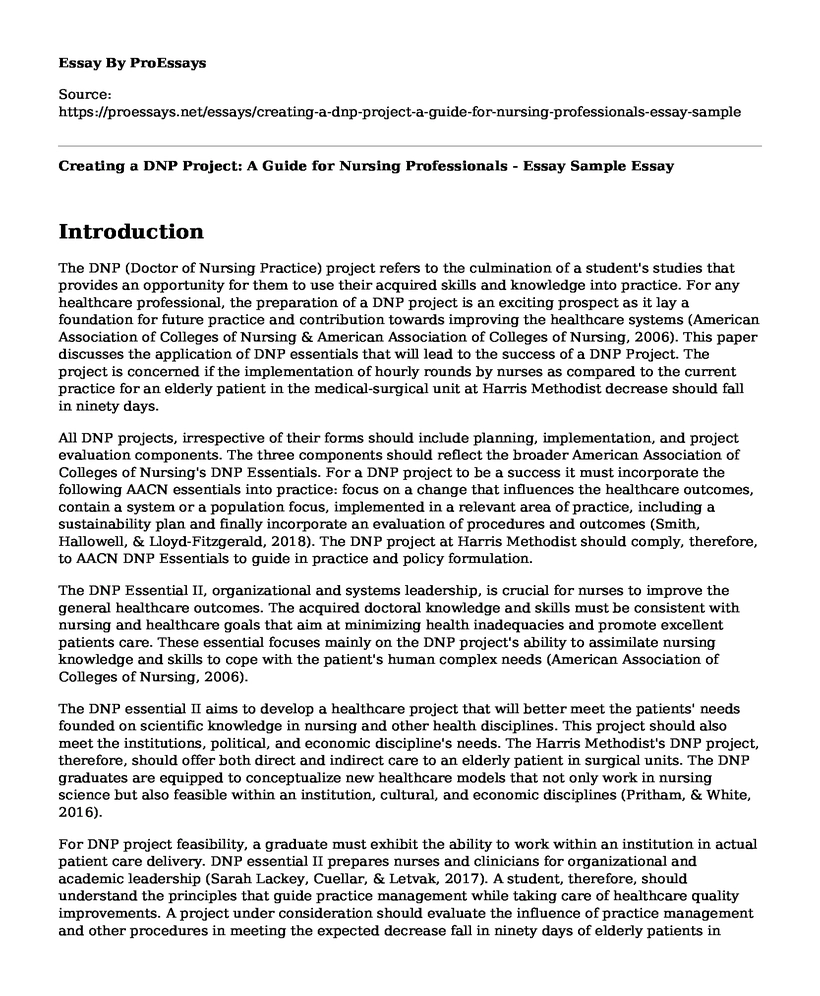Introduction
The DNP (Doctor of Nursing Practice) project refers to the culmination of a student's studies that provides an opportunity for them to use their acquired skills and knowledge into practice. For any healthcare professional, the preparation of a DNP project is an exciting prospect as it lay a foundation for future practice and contribution towards improving the healthcare systems (American Association of Colleges of Nursing & American Association of Colleges of Nursing, 2006). This paper discusses the application of DNP essentials that will lead to the success of a DNP Project. The project is concerned if the implementation of hourly rounds by nurses as compared to the current practice for an elderly patient in the medical-surgical unit at Harris Methodist decrease should fall in ninety days.
All DNP projects, irrespective of their forms should include planning, implementation, and project evaluation components. The three components should reflect the broader American Association of Colleges of Nursing's DNP Essentials. For a DNP project to be a success it must incorporate the following AACN essentials into practice: focus on a change that influences the healthcare outcomes, contain a system or a population focus, implemented in a relevant area of practice, including a sustainability plan and finally incorporate an evaluation of procedures and outcomes (Smith, Hallowell, & Lloyd-Fitzgerald, 2018). The DNP project at Harris Methodist should comply, therefore, to AACN DNP Essentials to guide in practice and policy formulation.
The DNP Essential II, organizational and systems leadership, is crucial for nurses to improve the general healthcare outcomes. The acquired doctoral knowledge and skills must be consistent with nursing and healthcare goals that aim at minimizing health inadequacies and promote excellent patients care. These essential focuses mainly on the DNP project's ability to assimilate nursing knowledge and skills to cope with the patient's human complex needs (American Association of Colleges of Nursing, 2006).
The DNP essential II aims to develop a healthcare project that will better meet the patients' needs founded on scientific knowledge in nursing and other health disciplines. This project should also meet the institutions, political, and economic discipline's needs. The Harris Methodist's DNP project, therefore, should offer both direct and indirect care to an elderly patient in surgical units. The DNP graduates are equipped to conceptualize new healthcare models that not only work in nursing science but also feasible within an institution, cultural, and economic disciplines (Pritham, & White, 2016).
For DNP project feasibility, a graduate must exhibit the ability to work within an institution in actual patient care delivery. DNP essential II prepares nurses and clinicians for organizational and academic leadership (Sarah Lackey, Cuellar, & Letvak, 2017). A student, therefore, should understand the principles that guide practice management while taking care of healthcare quality improvements. A project under consideration should evaluate the influence of practice management and other procedures in meeting the expected decrease fall in ninety days of elderly patients in surgical units through hourly rounds by nurses.
Development and analysis of efficient strategies to counter emerging practices and technology should be a top priority while developing or practicing a DNP project. A good project should be able to access the risks that can arise and ways to manage them based on professional levels and standards. It should be able to cater to different organizational needs and a variety of patients. This calls for the adoption of economics, finance, and accounting practices to develop a project that can meet the patient's reach. This results in an improvement in healthcare systems (Smith, Hallowell, & Lloyd-Fitzgerald, 2018).
Conclusion
In conclusion, the DNP project is an applauded method of preparing nurses to transition into academia and leadership roles. It lays a foundation for the provision of requisite knowledge to perform specific functions within the healthcare systems. A well-designed DNP project is a benchmark for a student's educational knowledge and skills so far attained that can be crucial for future practice.
References
American Association of Colleges of Nursing, & American Association of Colleges of Nursing. (2006). The essentials of doctoral education for advanced nursing practice. https://www.aacnnursing.org/Portals/42/Publications/DNPEssentials.pdf
Pritham, U. A., & White, P. (2016). Assessing DNP impact using program evaluations to capture healthcare system change. The Nurse Practitioner, 41(4), 44-53. https://journals.lww.com/tnpj/Abstract/2016/04000/Assessing_DNP_impact_Using_program_evaluations_to.8.apx
Smith, S., Hallowell, S., & Lloyd-Fitzgerald, J. (2018). AACN's DNP essential II prepares clinicians for academic leadership: Three DNP graduates share their leadership journey. Journal of Professional Nursing, 34(1), 16-19. https://insights.ovid.com/professional-nursing/jpnur/2018/01/000/aacn-dnp-essential-ii-prepares-clinicians-academic/8/00004473
Sarah Lackey, Cuellar, N. G., & Letvak, S. (2017). Does a Doctor of Nursing Practice Degree Provide Preparation for Assuming a Magnet Program Director Role? Journal of Doctoral Nursing Practice, 10(1).
Cite this page
Creating a DNP Project: A Guide for Nursing Professionals - Essay Sample. (2023, May 06). Retrieved from https://proessays.net/essays/creating-a-dnp-project-a-guide-for-nursing-professionals-essay-sample
If you are the original author of this essay and no longer wish to have it published on the ProEssays website, please click below to request its removal:
- Intervention for Children With Synethesia: The Girl Who Heard Colors Essay
- Health Disparities Are Often Experienced by Minority Communities Within a Society Essay
- Obesity Article Review Paper Example
- Research Paper on Pediatric Obesity: Causes, Symptoms, Prevention and Treatment
- Elderly Health Care: Examining Its Impact on Life Satisfaction - Essay Sample
- Paper Example on Granny's Got Game: Uplifting Old-Age Tales of Basketball Teams
- Report Example on Cancer: Cellular Changes and Apoptosis







